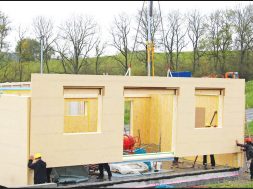Steel structures getting stronger
Construction of steel structures in India set to increase with the country looking for fast, reliable methods of construction to meet its demand
India is expected to become world’s second largest producer of crude steel in 2015-16, moving up from the fourth position. This result will lead to a rise in building of steel structures across the country as well as pave way for fast and positive growth of Indian infrastructure industry.
Market positionWith the demand for pre-engineered steel structures sets to increase in the country players within the market will be stepping up their offerings and services to stay ahead in the competition. Speaking on the present market scenario, Samir Sharan, CEO, ACME Cleantech Solutions, says, “ACME is one of the leading prefabricated infrastructure players, using PUF panels. We, at ACME, endeavour to make green approach profitable through world-class technology and manufacturing through pre-engineered construction, using optimum grade PUF material and sophisticated technology in synchronisation with international standards.”
D Raju, MD, Kirby Building Systems, feels, “Over the years, Kirby India has evolved from a mere manufacturer of PEB to a total solution provider which is capable of supplying a packaged solution for all building requirements while maintaining international quality standards and fulfilling the entire customer demand.”
Gautam Suri, Founder Director and CTO, Interarch Building Products, incorporates, “Interarch is one of India’s leading turnkey pre-engineered metal building and steel construction companies with market share of around 30 per cent in pre-engineered steel construction market.”
He also adds “Interarch caters to some of the most diverse steel building construction projects in India, with clients like Tata Motors, BHEL, Reliance Industries, General Motors, L&T Limited, Dabur India, Liugong,3M India Limited, PepsiCo India Holdings, ITC Ltd, P&G, Siemens Ltd and many more.”
Referring to the company’s market status, PV Rao, Managing Director, PEBS Pennar, states, “We started PEB division in Pennar 5 years back from scratch, and today we are in the top three. We are targeting to reach a revenue of Rs. 500 crore in fiscal 2014-15, and our aim is to reach revenue of Rs.1,000 crore in the next 3 years.”
Growth of steel structures in IndiaWith the expected improvement in economy and infrastructure the demand for steel structures is set to rise. With the increase in demand for steel structures India looks capable enough to produce the required amount of steel to support its growing demand in the coming years. Mr Rao believes, “We have sufficient steel production capacity in India for structural steel as well as PEBs. Currently, the supply capacity is more than the demand. I am sure, with the current positive environment created in the market by the new government, there would be growth in the demand for structure steel as well as PEBs.”
Mr Raju opines, “Structural steel demand is based on India’s economic growth and new CAPEX investments or announcement of new projects mostly in the construction industry consisting of infrastructure, industrial infrastructure and real estate segments. Recent announcement of increased investment in the infrastructure segment during the budget 2015 and revival of stalled projects including some new investments will help the growth of steel structures in India.” He adds, “PEB production capacity is 50 per cent more than the current market demand which is pegged at around 600,000 tonnes per annum. This excess capacity will help us meet the increased demand for PEB in coming years as the economy takes the growth path.”
According to estimates by World Steel Association 2013-14, the steel consumption has been growing globally at 2 per cent. And the same will grow by another 2.0 per cent in 2015 and will reach 1,594 tonnes. India has observed the encouraging signs of uptake of prefabricated technology from the past few years, and the future also looks bright for India. The government has also announced to provide housings for all by 2022. All these factors will add to the growth of prefabricated structures in India in the years to come.
“Steel definitely has great potential in the field of infrastructure. As we go ahead to explore newer technologies in construction like pre-engineered buildings, there would be furthermore avenues that would exploit the potential of steel as the key construction material,” says Mr Sharan.
Trends in the marketStructural steel in India offers numerous benefits to the modern construction sector, though there are major problems pertaining to the adoption of steel structures from traditional building elements. “People still tend to look the conventional method of construction as the best and cheaper method of construction overlooking the long-term benefits of constructing in pre-engineered steel,” explains Mr Suri.
Commenting on the trends, Mr Rao says, “The smart city and ‘Make in India’ initiative by the new government will definitely boost the industrial production in the times to come. Also, the decision of the government to source defence equipment from domestic market to a larger extent will significantly encourage industries in this segment.”
In the last decade, there has been increased acceptance of PEB due to rapidly expanding industrialisation in the country. Mr Raju states, “The changing market environment has led to an increase in shift towards more advanced technologies with one of them being PEB due to increasing demand from customers for faster project completion which in turn will give faster returns on their investments. Some of the other challenges faced by PEB industry include price volatility of raw material and availability of skilled manpower.”
Revving up of businessInfrastructure development in India will rely majorly to the PEB industry for their fast and reliable steel structural quality. Projects like the smart cities and development of new warehouses, airports and plants will help the industry increase in terms of capacity and market share.
Mr Sharan says, “ACME is actively developing large-infrastructure projects using PEB and prefab technology. There are case studies clients who are choosing new-age technologies over the conventional construction. There is an increasing trend of utilising steel in warehousing, industrial shelters, commercial buildings, hospitals and many other large-scale projects”
ACME is also working towards increasing awareness about the new technologies at various levels through inclusion of all stakeholders for the benefit of society-at-large through bringing down the carbon footprint, decreasing the time and input costs, and more efficient infrastructure.
Mr Rao indicates, “We have added new product portfolios to cater to structural steel, solar mount module structures and low cost housing and communication towers. We have plans to start our second manufacturing unit in north India soon. We are also conducting surveys in African market as well as commonwealth countries to find out opportunities.”
Future of steel structure in IndiaIndia is expected to become the world’s second largest producer of crude steel in 2015-16, moving up from the fourth position. This means that the country will be producing more steel. There is undoubtedly, a very promising future for this sector in the coming years. The Indian pre-engineered market is now experiencing a demand shift to new applications due to infrastructure development in the country and advantages of pre-engineered steel structures.
Mr Suri says, “Steel use has increased exponentially in applications like airports for terminal buildings and aircraft hangars, multi-storey buildings for hospitals, educational institute, commercial office buildings, shopping malls, stadiums, metro stations and so forth.” The consumption of steel has been growing considerably in the past 10 years. According to Mr Rao, “The current per capita consumption is 55 kg as against 250-300 kg in developed countries. The use of steel structures has been on the rise in view of the distinct advantages compared to the concrete structures.”
Mr Raju states, “The central government’s ‘Make in India’ campaign and recent approval of ordinance for amendment of Land Acquisition Act for development of infrastructure and industry related projects will further give a boost to the economic growth.” He further adds, “These reforms and many other such initiatives in coming future as promised by the government is expected to make the Indian construction and infrastructure segments much more stronger and increase its percentage share in the overall GDP contribution, thereby giving a positive growth momentum to the PEB industry over the next decade or so.”
Steel building in the coming years will be value investment because of its fast-paced construction and the newer technologies. With a number of housing projects and the verge of delays adding up to the overall cost, people will have to move towards steel structures.
————–The use of steel structures has been on the rise in view of the distinct advantages compared to the concrete structures.
Gautam Suri, CTO & Founder, Interarch Building Products————-
————-There is an increasing trend of utilising steel in warehousing, industrial shelters, commercial buildings, hospitals and many other large-scale projects.
Samir Sharan, CEO, ACME Cleantech Solutions————
———–The smart city and ‘Make in India’ initiative by the new government will definitely boost the industrial production in the times to come.
P V Rao,Managing Director, PEBS Pennar———–
———PEB production capacity is 50 per cent more than the current market demand which is pegged at around 600,000 tonnes per annum.
D Raju, MD, Kirby Building Systems
15
Cookie Consent
We use cookies to personalize your experience. By continuing to visit this website you agree to our Terms & Conditions, Privacy Policy and Cookie Policy.









